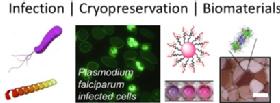Matthew Gibson
Technical Summary
The Gibson group’s research is highly interdisciplinary, applying biomaterial solutions to healthcare challenges. This research is summarized below
i) Infection. The first stage of many infections is the adhesion of the pathogen to glycans (sugars) on cell surfaces. Multivalent systems which present similar carbohydrates offer an opportunity to inhibit these interactions or can be coupled to sensors to provide a measureable output. We have developed polymer and nanoparticle systems which have been shown to be potent inhibitors of bacterial toxins (e.g Cholera) and developed multiplexed, colour-changing sensors capable of detecting toxins or whole bacteria, in less than 10 minutes, without the need for any infrastructure.
 ii) Cryopreservation. Nature has evolved many elegant solutions to enable life to flourish in low temperature environments. Arctic fish produce antifreeze glycoproteins (AFGP)s which act to slow ice crystal growth – this is of huge technological importance, and could be used to reduce ice growth in frozen tissue/cells, but AFGPs are hard to synthesize and have biocompatibility concerns. We have developed fully synthetic polymers which mimic the function of AFGPs but are scalable, biocompatibale and highly tunable. Using these we have shown that donor blood (and other cells) can be cryopreserved without the need for organic solvents, such as glycerol or DMSO. Considering the urgent shortage of donor cells and tissue, this technology could have significant impact.
ii) Cryopreservation. Nature has evolved many elegant solutions to enable life to flourish in low temperature environments. Arctic fish produce antifreeze glycoproteins (AFGP)s which act to slow ice crystal growth – this is of huge technological importance, and could be used to reduce ice growth in frozen tissue/cells, but AFGPs are hard to synthesize and have biocompatibility concerns. We have developed fully synthetic polymers which mimic the function of AFGPs but are scalable, biocompatibale and highly tunable. Using these we have shown that donor blood (and other cells) can be cryopreserved without the need for organic solvents, such as glycerol or DMSO. Considering the urgent shortage of donor cells and tissue, this technology could have significant impact.
iii) Cellular Delivery and polymeric drugs. Many new drugs fail due to poor pharmacokinetics or high toxicity. We have developed model systems to probe nanoparticle/cell interactions with the aim of improving delivery, or to generate polymers which are themselves bioactive.
Much of this work is undertaken in collaboration with microbiology and clinical colleagues a well as UK/International industry.
Selected publications:
Mitchell DE., Lovett JR, Armes SP and Gibson MI, Angewandte Chemie, 2016, 55, 2801 - 2804, "Biomimetic Block Copolymer Worms Combined with an Ice-Inhibiting Polymer Enable Solvent-Free Cryopreservation of Red Blood Cells" link
Deller, R.C., Vatish, M., Mitchell, D.A., Gibson, M.I., Nat. Commun., 2014, 5, 3244, "Synthetic polymers enable non-vitreous cellular cryopreservation by reducing ice crystal growth during thawing" Link
Richards, S-J., Jones, MW, Hunaban, M., Haddleton, DM., Gibson, M.I., Angew. Chem. Int. Ed., 2012, 51, 7812 – 7816 "Probing Bacterial Toxin Inhibition with Synthetic Glycopolymers Prepared by Tandem Post-Polymerization Modification: Role of Linker and Carbohydrate Density"
Otten, LC, Fullam, E, Gibson, M.I. Molecular Biosystems, 2016, 12, 341 - 344 'Discrimination between Bacterial Species by Ratiometric Analysis of their Carbohydrate Binding Profile' link

